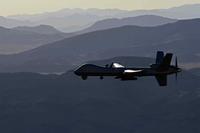Theyre an enigma of flight. Rats with wings that guide themselves through the air with chirps and clicks. And now the Air Force is taking notice to see how the mysteries of a bats ability to fly can help make better aircraft in the future.
The Boston Globes Bryan Bender has an outstanding piece today on a $6 million research program at Brown University intended to uncover the mechanics and science of chiroptera flight for human (or robotic) applications...
From the Globe:
Research so far has found that bats can carry up to 50 percent of their weight and execute airborne maneuvers that would make a bird or plane fall out of the sky. Moreover, scientists believe the hundreds of tiny sensors covering bat wings could be the key to their most impressive airborne maneuvers, a discovery that engineers could replicate with networks of sensors and computers on military aircraft.
If researchers can unlock the secrets of bat flight, it could have wide-reaching implications, according to Air Force and Brown officials. They say the project has the potential to revolutionize aircraft design and could lead to the creation of smaller, more efficient military air vehicles that can maneuver in tight spaces as well as gather intelligence and airlift supplies through forbidding terrain.
"The Air Force envisions a future in which they have lots of autonomous air vehicles that can take on different kinds of missions and that don't have pilots," said Sharon Swartz, an evolutionary biologist at Brown who is helping run the project. "We know a lot about the aerodynamics of large things moving very fast. There is almost nothing known yet about the basic physics of bat flight."
Unlike birds or insects, whose wings are comparatively rigid, bats have wings with more than two dozen independent joints, much like a human hand. That allows them to manipulate the thin, flexible membrane that covers the wings in ways that can generate more lift or greatly reduce drag.
Surfaces of bat wings also curve more than a bird's -- providing greater lift for less energy -- while their extraordinary flexibility allows them to make a 180-degree turn in less than half their wingspan, a radius impossible for any bird or existing plane, according to the initial findings.
The Air Force is particularly interested in how pregnant female bats can fly throughout the gestation period, even though the feat can amount to hauling half their body weight. Understanding the physics of supporting so much weight in flight could help aircraft designers dramatically increase the payloads of current aircraft models, project officials believe.
Bats, researchers have found, can fly with badly damaged wings and show no discernible changes in flight control -- an intriguing discovery that could have drastic implications for aircraft flight safety...
...bats are physically different from other animals that fly; their thin, membrane-like wings are complex appendages with joints similar to a human elbow and wrist. During flight, they have precise control over the shape of the wing, making them much more maneuverable than birds or insect wings.
This is especially true in caves and forests -- difficult, obstacle-filled environments in which conventional flying machines normally cannot operate.
Researchers, meanwhile, have begun to understand how bats can turn at extremely steep angles without losing lift or stalling during flight.
"After 10 or 15 degrees of tilt an aircraft just stops catastrophically and plummets," said Swartz. The bats, she said, can tilt their wings at angles as steep as 60 degrees with little or no stall. Part of the reason, she believes, is that bats can stretch the wing membrane in midair, expanding its surface area and increasing lift, something bird or aircraft wings cannot do.
Those same characteristics appear to enable bats to fly with relatively large loads, a feature being studied by inserting saline into the laboratory bats to temporarily make them heavier than normal.
Some bats in the laboratory have lost upwards of 25 percent of their wings "before we can pick up with the naked eye any difference in their flight," according to Swartz.
The project is also just beginning to study what appear to be sensory cells, described as tiny hairs, that cover the wing surfaces and may also help explain why bats are so adaptable in flight. Neuroscientists at the University of Maryland have been enlisted by Brown to study what role the sensors play in sending instructions to the bat's brain to make wing adjustments to compensate for changes in air flow.
-- Christian








